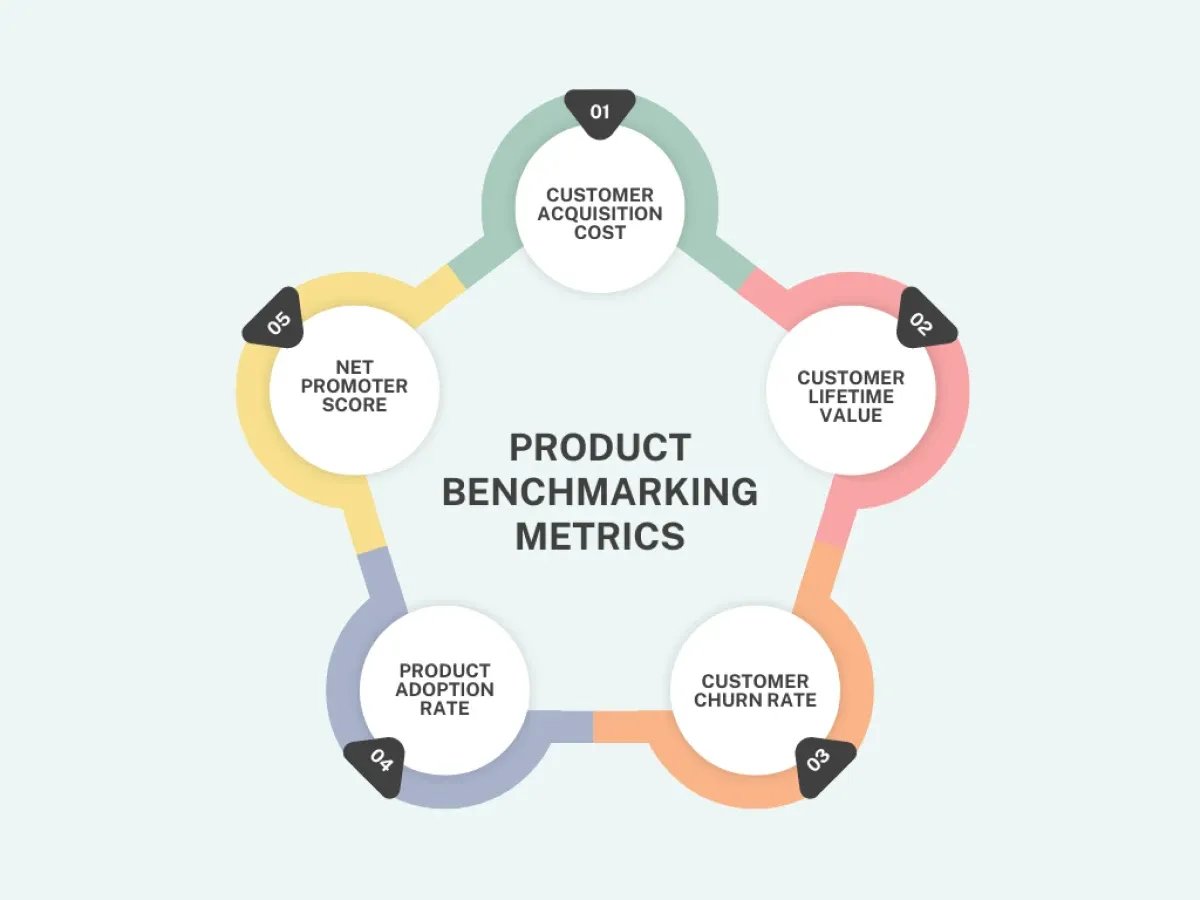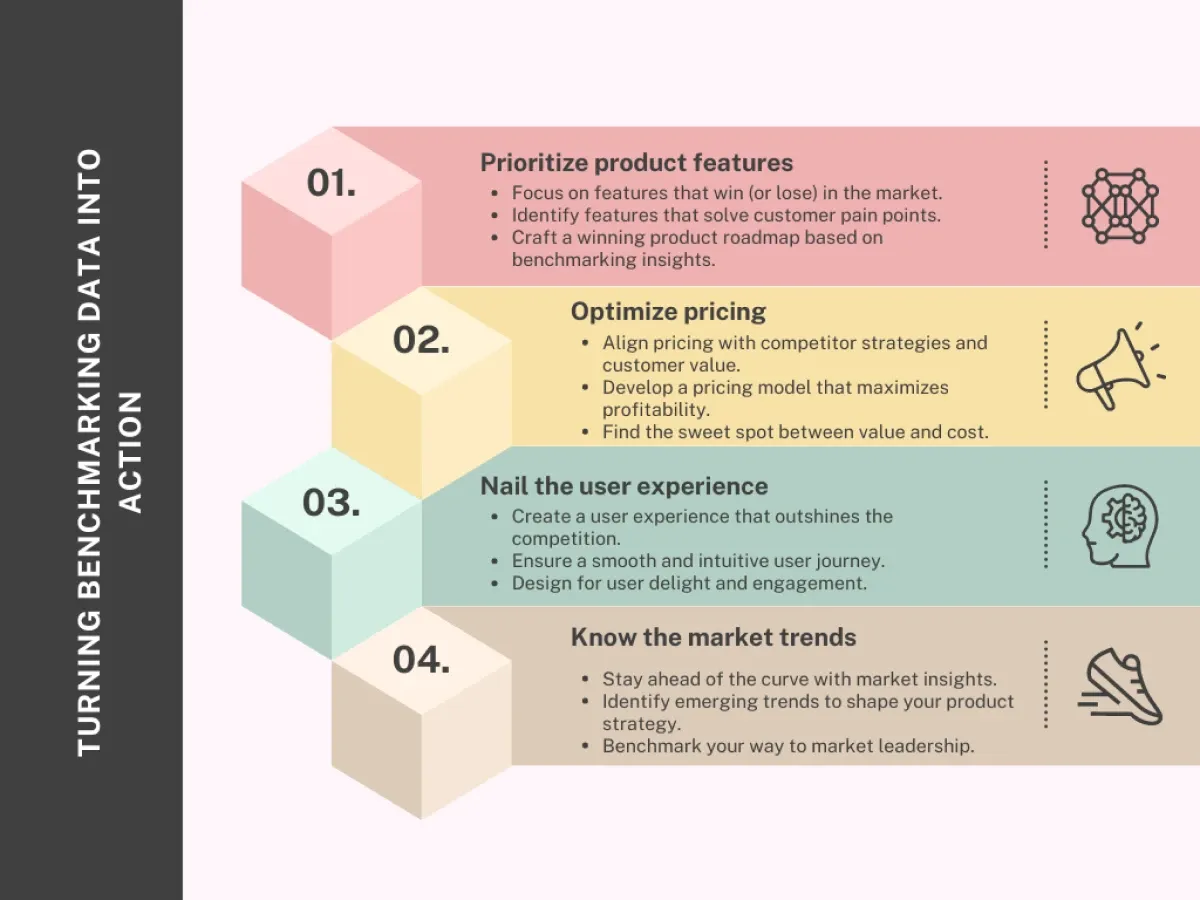Don't be a newbie in a shark tank – use product benchmarking to gear up
Discover how product benchmarking helps you stack your product against competitors, equips you to be competitive and emerge as a leader.

If you had to swim in a shark tank (let’s face it, the world is too competitive to not think of the “big boys and girls” as sharks), would you jump right in? You could, but your anxiety will probably turn your legs or fins to jelly, you may end up swimming in circles or against the tide, and snap! Those powerful jaws would have snuck up on you and ended your participation in the race.
Being a B2B SaaS product business today is no different from swimming among the sharks. No matter how cool, or great, or noble your idea is, you need your eyes on the market and your competitors. You need to figure out where your product fits and how you want to position yourself. Even if you get a few customers, you may believe you’re doing well, but you won’t know just how well. That’s where product benchmarking comes in.
Simply put, product benchmarking is about stacking your product and its “success” with the products of others. You gather intel on your competitors, and their positioning, analyze their metrics, and then put yourself up against them. Of course, it’s not about imitating your competitors or walking on the same path as them. It’s about finding out what your competitive advantage could be and how you could stand out in a crowded marketplace.
For when it comes to diving into the shark tank, product benchmarking builds your life jacket, hands you a compass and tells you how fast you need to swim to escape the sharks.
Product benchmarking metrics for B2B SaaS
Knowing what to track is just as important as tracking the numbers. There are several SaaS metrics (perhaps too many) that a business can monitor. So which ones should you be paying particular attention to?

How much does it cost to land a customer?
The customer acquisition cost (CAC) tells you exactly how much it costs to acquire a new customer. This is important to understand as it tells you whether your marketing and sales campaigns are running efficiently. Say your competitor has a significantly lower CAC. This might indicate a more efficient marketing strategy on their end, or perhaps they have a more attractive pricing model.
How much is a customer worth?
Not all customers are equal – some end up paying you more for your business compared to others. Customer lifetime value (CLTV) tells you how much revenue a customer generates throughout their relationship with your product. This is especially useful for SaaS businesses that run on subscriptions. If your CLTV is lower than your competitor's, it could indicate that you need to explore strategies for increasing customer retention and engagement. According to research, a mere 5% increase in customer retention can lead to over 25% increase in profit. This highlights the power of keeping your existing customers happy and engaged.
Are your customers saying goodbye too soon?
Customers come and go, but if they leave too soon, that could indicate that while they believed in the promise you sold to them, something went wrong. It could be a usability issue, a lack of features or flows they wanted, or simply that they had a bad experience. Customer churn rate tracks the percentage of customers who cancel their engagement with you during a specific period. Benchmarking your churn rate helps you identify red flags – after all, you don’t want to lose out on business any faster than you have to.
How quickly are your users embracing your product?
It seems like happy news when you sell a product but that’s not good enough. You need customers to use your product too – or they’ll never renew! Product adoption rate helps you understand how quickly new customers start using your product's core features. A slow adoption rate might indicate that you have set up a complex onboarding process or your platform’s UI is not that user-friendly. Comparing your adoption rate to industry standards can help you identify if there's room for improvement.
Would your customers recommend you?
Perhaps your customers use your product out of habit (which is great) but if they are not willing to recommend you to others it may mean that they don’t really trust you or find value in your product. Net promoter score (NPS) is a way to measure customer satisfaction. Benchmarking your NPS can reveal areas where you're exceeding customer expectations or falling short. For instance, B2B SaaS companies typically aim for an NPS of at least 40. A score below this benchmark might suggest you need to work on your customer experience strategy.
Look beyond the numbers
Not all benchmarks are created equal. So while you must track all those metrics and look at the numbers, you also need to consider the context. That's why taking a 10,000-foot view is crucial.
- Focus on trends, not just absolute numbers: There’s no point in getting hung up on comparing your CAC to a competitor's if they target a completely different customer segment. Instead, tracking how your own CAC changes over time could tell you if are getting more efficient at customer acquisition. That would be a real win for you. So while tracking numbers don’t forget to look at that trend line.
- Target the right competitors: Don't waste time benchmarking against companies with vastly different business models or target countries. Find competitors who serve a similar customer base and offer comparable solutions. Otherwise, you’ll just end up comparing apples to oranges.
- There’s more than numbers to track: Qualitative data matters too. Numbers are important but so is the human element. Analyze user feedback, reviews, social media sentiment, and industry reports to understand how your product is perceived compared to the competition.
How to make the best use of product benchmarking
Product benchmarking isn’t just about collecting the data points and reporting them to senior leaders. It’s a strategic approach you take to identify areas where your product excels and whether there’s scope for improvement. Here are some ways in which you can leverage insights from product benchmarking to make informed decisions and guide your teams toward meeting their goals.

Prioritize product features
Benchmarking can help expose the gaps between your product and your competitor’s. Ask these questions –
- Which features are consistently praised or heavily criticized in competitor reviews or on social media? This can reveal areas where competitors are excelling or falling short, helping you identify features to prioritize in your own product roadmap.
- Are there any features offered by others that address a pain point that is common to your target audience? Benchmarking can help you identify these missing pieces so you can innovate and prioritize features that directly alleviate customer pain.
- How do your product’s features compare to those of your competitors in terms of usability and efficiency? Are competitor features easier to use? Do they deliver results faster? Use these insights to refine your own feature set and create a stronger user experience.
Optimize pricing
While features are important, a product's price tag can make or break its success. Here's how product benchmarking can help you optimize your pricing strategy:
- What kind of pricing models do your most successful competitors use? Perhaps they are offering tiered subscriptions with varying feature sets? Benchmarking can reveal such insights – so you can compare your own pricing structure and identify potential areas for improvement.
- Is there any correlation between pricing tiers and features or services offered by your competitors? Benchmarking can help you understand how competitors bundle their offerings at different price points.
- How does your customer acquisition cost compare to the average CLTV? A healthy CAC::CLTV ratio is crucial for maintaining profitability. Ideally, customer lifetime value should significantly exceed acquisition cost – you need to earn more from a customer than you spend on acquiring them. Benchmarking competitors can reveal strategies to lower CAC and increase CLTV – something to inspire your marketing, sales, and customer retention efforts.
Nail the user experience
A cluttered or clunky interface can be the death knell of even the most feature-rich products. Benchmarking can help you assess how brilliant your UX is, and whether it can successfully engage users.
- How intuitive and user-friendly are competitor interfaces compared to yours? Benchmarking can reveal areas where competitors excel or fail in terms of UX design – everything from the color palette to the number of menu items to what’s shown vs. what’s hidden – could be interesting to analyze for identifying best practices and potential pitfalls to avoid in your own product.
- Which onboarding processes do competitors use for successful product adoption and getting users to the activation moment fast? Benchmarking can shed light on how competitors introduce new users to their products – whether it’s through in-app tutorials or an entire self-service onboarding flow, understanding other’s strategies can help you create a frictionless journey for your first-timers.
- Are there specific features within competitor products known for their exceptional value? Benchmarking can help you identify "wow" features and understand what makes users want to use them repeatedly. Use these insights to inspire creative improvements and elevate the user experience of your own product.
Know the market trends
Benchmarking can help you foresee which way the market is moving, revealing the trends that will shape your industry's future. Here are some questions you can ask while conducting the benchmarking exercise.
- How are competitor marketing or sales strategies evolving to reach and engage target audiences? Benchmarking competitor tactics can reveal new channels, strategies, and messaging techniques that resonate with people in your target audience. You can use these insights to refine your own marketing approach and ensure your product reaches the right people at the right time.
- What integrations are becoming increasingly popular within your industry? Benchmarking can help you identify which integrations are gaining traction and are in high demand from customers. The SaaS ecosystem evolves quite rapidly and users appreciate being able to “connect” different apps together. This information can be invaluable for informing your product roadmap and ensuring your offering remains well-connected within the evolving ecosystem.
- Are there new security protocols or regulatory standards gaining traction among competitors? Benchmarking can keep you on top of the latest developments within your industry. By understanding the evolving security and regulatory landscape, you make sure that your product remains compliant and meets the highest industry standards.
Swim with the sharks confidently
You don’t have to swim blind in a crowded shark tank – you can (and should!) use product benchmarking to your advantage.
By monitoring key product metrics like CAC, CLTV, churn rate, and adoption rate, you can stack yourself against others in the marketplace to compare yourself. But product benchmarking is a lot more than finding out how many cookies your competitors have. You get to understand which way the world is moving, what your target audience responds to, and how you can stand out.
This knowledge can be used by everyone from the product, sales, marketing, and even customer experience teams to prioritize features, optimize pricing, craft a relevant value proposition, and run a stellar customer experience process.
Product benchmarking is not a one-time or a month-long activity. It is a continuous process, one in which you invest to come out strategically stronger. You do this to not only pre-empt any attacks from sharks but also establish yourself as a market leader so that when potential customers face a sea of options, you'll be the lighthouse guiding them to your product.
